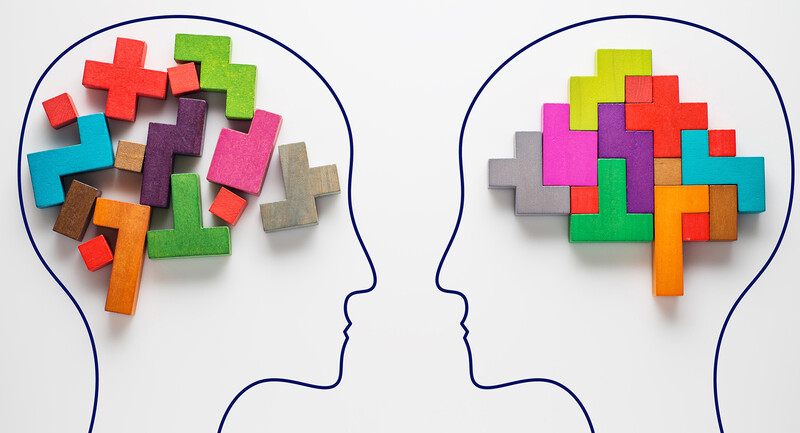Miguel enters my classroom, puts his head down, and his knee starts shaking. I sense he’s anxious and needs a stress ball. Theo storms into class, curses at his friend, pulls out a chair, and bangs his fist on the table. As I gauge the emotional temperature in my 10th grade ELA class today, I notice Marcus, a normally loquacious student, sitting silently with a stoic expression on his face. Marcus has told me he internalizes his frustration, so his silence is a red flag. Though Jenny looks OK at this moment, she’s been making a lot of self-deprecating comments lately, indicating she might be spiraling because of her anxiety. I make a mental note to check-in with Jenny after class; maybe a brief one-on-one will increase her awareness of her thinking patterns.
Before we move on from this morning’s Do-Now, I strategize a bit. I know Theo and Marcus will benefit from nonverbal check-ins and moving to quieter spaces. They’re too angry to speak and not in a place to listen, and a crowded classroom might escalate their emotions. So I quickly text a support staff member before jotting short messages on sticky notes to both students—telling them I’m aware of their needs, which we’ve discussed before—and placing the notes on their desks.
Teens’ Mental Health Is in Trouble
Anyone who spends an hour in a high school classroom can recognize the severity of the student mental health crisis. Statistics paint a grim picture. More than 40 percent of high school students reported experiencing “persistent feelings of sadness or hopelessness,” according to the Centers for Disease Control and Prevention’s most recent Youth Risk Behavior Survey. That figure rose to 69 percent for students who are members of the LGBTQ+ community. The same survey showed approximately one in five high school students has considered suicide (CDC, 2023). This crisis has implications, among others, for students’ academic success: Research shows that students experiencing mental health challenges are less likely to attend school (School Avoidance Alliance, n.d.). Poor mental health can also affect eating and sleeping routines that impact students’ ability to learn.
My students’ experiences bring these numbers to life. They report sleepless nights because their minds don’t stop racing; they feel unable to manage their anxiety in loud, crowded classrooms; and they express hopelessness and loneliness. Some students feel too anxious or depressed to attend school. Late work piles up, exacerbating their anxiety and hopelessness. At the urban school serving mostly Latinx students where I taught last year, teachers had to respond to students with feelings like this every day.
Contributing to this mental health crisis is the reality that most schools, at least from my experience, have limited training and infrastructure to support student mental health. In an ideal world, conversations about how to support student mental health, including trainings facilitated by experts, PD sessions about mental health literacy, and schoolwide discussions that include students, would be frequent in schools—but that’s not the case.
For many students, school is a place that negatively impacts their mental health. Early start times, an emphasis on bell-to-bell instruction, control of what students can wear and when they can eat or take breaks, and many other aspects of students’ daily experience often make school a source of frustration. But it doesn’t have to be. Every student deserves to learn in what Alex Shevrin Venet describes as a “healing environment,” where “students are validated, affirmed, and cared for, one in which students feel a sense of agency and the ability to make positive changes in the world” (2021).
Taking Action—Starting with Listening
Although schoolwide initiatives to address students’ mental health are often lacking, teachers can take tangible actions to support students’ mental health. It must begin by having honest, direct conversations with students about mental health and well-being in our classrooms—and must include asking students what helps them maintain their well-being.
It must begin by having honest, direct conversations with students about mental health and well-being in our classrooms.
I initiated this work with my students in spring of 2023. As a project for an education graduate course I was taking, I set out to learn how my students believed teachers could support their mental health. I drew on the work of Shane Safir, who frames listening as “a physical, emotional, cognitive, and even spiritual act rather than a clinical method of ‘gathering data’” (2021). Such listening goes beyond methods like standardized surveys; it involves considering students’ nonverbal language, tone, and emotion, and identifying themes in what they share.
I planned to conduct small-group discussions with my 10th grade students, gathering all who were interested into small groups of about four for each discussion. I posed four questions as a framework for students to express what they expect of a teacher who supports their mental health—both in terms of a teacher’s knowledge and beliefs and in terms of their behavior:
1. What do teachers need to know to support student mental health?
2. What do teachers need to believe to support student mental health?
3. What do teachers need to say to support student mental health?
4. What do teachers need to do to support student mental health?
I explained my project and asked my students if they were interested in participating. Most jumped at the opportunity. So, near the end of a day of state-mandated standardized testing, when we had some free time, I facilitated discussions with students in several small groups. We used the four questions as our starting point. The conversations seemed cathartic for them. Students built on each other’s ideas, nodding in agreement with what their peers shared. They described classrooms in which mental health is rarely discussed or acknowledged and inadequate opportunities to develop rapport with school counselors. Many students questioned how schools can purportedly care about student mental health when many actions or policies that public education prioritizes—like standardized testing, bell-to-bell instruction, or zero-tolerance policies—worsen their mental health.
Students’ comments about what they needed from teachers pointed to actionable steps educators could take at both the classroom and school levels. Using my notes and drawing upon the central themes from our conversations, I created a “mind map” graphic that included specific ideas my students suggested in response to the four questions (see Figure 1 above). Some suggestions included:
Creating spaces where students can go if they need to cry.
Asking students whether they need time or privacy before processing a conflict.
Providing time for one-on-one check-ins with a trusted adult.
Offering places where kids can do deep breathing and meditation when overwhelmed.
When asked what teachers should know or believe, students said teachers should know how to approach students differently based on their personalities and how to respect emotional boundaries. Several said they need teachers who believe that mental health is real.
Changes I Made That Changed Students
My students left me with plenty to contemplate. One thing I learned is that students often feel adults ask young people for input, but don’t make any changes based on what they say. This reinforces many students’ belief that their ideas don’t matter to adults. I remember one student answering question #2 with, “[Teachers need] to believe students’ ideas are worth listening to.”
Students often feel adults ask young people for input, but don’t make any changes based on what they say.
Educators need to remember that if we believe students’ ideas contain value, we must let their feedback inform our practice. To do otherwise undermines the notion of empowering student voice and reinforces the power differential in schools between adults and students (Caetano, Freire, & Machado, 2020). So, I realized the next step in my project had to be implementing some of my students’ ideas. I posted on our classroom wall the mind map I created with their suggestions of what teachers could know, believe, or do to protect students’ mental wellness. I saw this graphic as a reference point, and it prompted me to reconsider how I approached and interacted with students over the final months of the school year.
I changed my practice in concrete ways. For example, I shifted from periodically having kids use a mood meter—a tool to identify and communicate emotions in the moment—to incorporating it into the daily Do-Now that I began classes with. Students selected at least two emotions reflecting how they were feeling and could choose to explain why they felt that way. “Chill” and “tired” were common responses, but others such as “anxious,” “hopeless,” or “lonely” indicated the need for a one-on-one check-in. I also purchased more stress balls and pop-its for students to use as fidgets and dimmed the lights and played soft music during independent work time to reduce the potential for sensory overload.
I’d noticed that many strategies my students identified as beneficial for their mental health reinforced an assertion from trauma expert Micere Keels: “If the underlying cause of students’ disruptive behaviors is mental health distress, punitive and exclusionary discipline will worsen both their mental health and their acting-out behaviors. Students need to feel safe with you” (2021). So, I took steps to help all students in my classes feel safe. I began doing the kind of quick read of students’ emotional tone described at the beginning of this piece and offering in-the-moment supports to extra-stressed learners if possible. If a student was disruptive, rather than immediately reprimand them, I found ways to inquire sensitively about the root of that student’s behavior and help address the problem if I could, rather than immediately giving a consequence.
These changes had a clear impact on students. Relinquishing some of my control empowered us all, and there were fewer conflicts in my classroom. Because of our more frequent positive interaction, it became easier to reason with students about cellphone usage or the number of times they requested a bathroom pass. Normalizing conversations about mental health established my classroom as a space where more students were comfortable sharing when they didn’t feel OK—and advocating for themselves. One student who participated in my project reflected that talking about mental health had helped him “feel safe” in my classroom and established “a sense that you cared and you were there for me, not just for my schoolwork.”
Let’s Help Each Other Talk About Mental Health
Initiating conversations about mental health with students—or colleagues and families—isn’t easy and must be done sensitively. It’s best to do so with students you already have some relationship with; by the time I facilitated these conversations, I had cultivated relationships with these students and their caregivers. Teachers’ comfort level engaging in these conversations will vary, and they will require support.
School leaders must focus on building teachers’ capacity for discussing mental health and well-being with their students by modeling practices like check-ins in meetings, making student well-being a regular topic of conversation in meetings, and reinforcing to educators the importance of taking care of their own well-being. Exhausted educators who don’t feel supported by their administrators will struggle to address students’ emotional needs. It’s important to help teachers maintain connections with school counselors, social workers, and other adults who students trust at school; a teacher shouldn’t be the only person a student feels comfortable talking to.
As one of my students explained, 'Teachers need to believe that mental health is more important than academics.'
In fact, one of the most important interventions school and district leaders can take involves improving the mental health literacy of school communities—enhancing stakeholders’ understanding of mental health and promoting conversations about positive mental health and well-being at schools.
On teachers’ part, even as we center students’ ideas about mental health and alter our practice to improve their in-school experiences, our support for mental health shouldn’t end there. We should simultaneously work for systems-level change, advocating for policies and resources that will contribute to student mental health. We must speak up when we notice a policy adversely affecting our students’ well-being. I believe in playing the long game—advocating for students’ needs in meetings, union contracts, etc., while simultaneously listening to our own students’ voices and meeting their needs.
Using Our Power in the Classroom
Teachers have power to cultivate healing environments in our classrooms. Teachers choose how to navigate conflicts, determine whether to prioritize relationships or compliance, and have ample opportunities to model social-emotional skills. We can either reinforce the stigma around mental health by treating it as taboo or we can normalize conversations, with healthy boundaries, about emotional well-being. Let’s use our power to support our students’ well-being. And let’s ensure students’ voices are placed at the center of these conversations—after all, no one understands students’ mental health needs better than they do.
Above all else, let’s prioritize better supporting student mental health—whether at the district, school, or classroom level. As one of my students explained, “Teachers need to believe that mental health is more important than academics.”
Author’s Note: All student names are pseudonyms.









